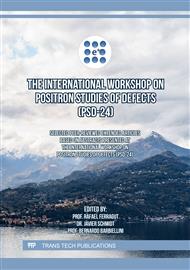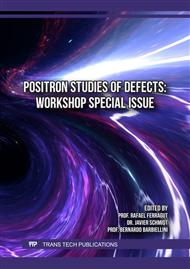p.3
p.13
p.23
p.37
p.47
p.55
p.63
p.69
Investigation of In-Flight Annihilation of Positrons Using Coincidence Doppler Broadening Spectroscopy
Abstract:
Doppler Broadening Spectroscopy (DBS) of the positron electron annihilation line allows the detection and analysis of defects in materials. DBS uses the fact that during the annihilation momentum has to be conserved and is therefore transferred from the annihilating positron-electron pair to the annihilation gamma quanta. As a sufficient approximation the positron is assumed to be thermalized in the solid when it annihilates with an electron. In that case, the dominant fraction of the transferred momentum originates from the electrons. However, when implanting high-energy positrons a small fraction of positrons (typicylly less than 1%) will annihilate with electrons before thermalizing. This process of in-flight annihilation can be differentiated from annihilation of thermalized positrons by Coincidence DBS (CDBS). We used the CDB Spectrometer at the NEutron induced POsitron source MUniCh (NEPOMUC) in order get a deeper understanding of in-flight annihilation in several materials of different densities and core annihilation probabilities. We utilized a 22Na source as positron emitter which not only provides insight into the thermalization process of positrons, but also extends the capabilities of the CDB spectrometer.
Info:
Periodical:
Pages:
3-12
Citation:
Online since:
July 2025
Authors:
Keywords:
Price:
Сopyright:
© 2025 Trans Tech Publications Ltd. All Rights Reserved
Share:
Citation:



